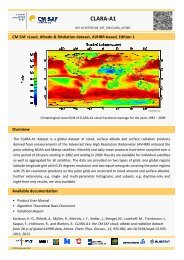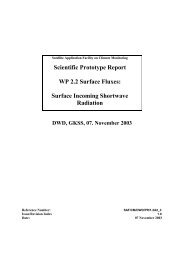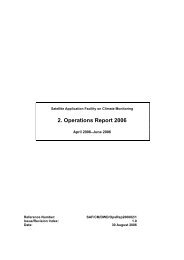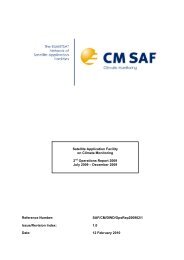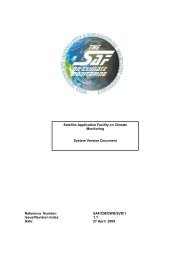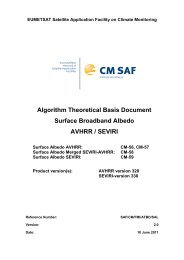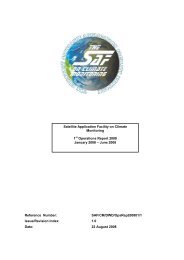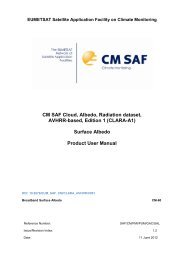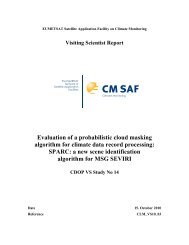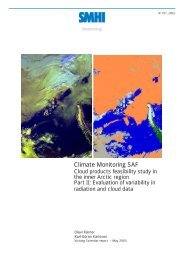Aerosol retrievals from METEOSAT-8 - CM SAF
Aerosol retrievals from METEOSAT-8 - CM SAF
Aerosol retrievals from METEOSAT-8 - CM SAF
Create successful ePaper yourself
Turn your PDF publications into a flip-book with our unique Google optimized e-Paper software.
<strong>SAF</strong> on Climate Monitoring Visiting Scientists Report Doc. No: 1.0<br />
Issue : 1.0<br />
Date : 4 October 2006<br />
4 User requirements<br />
4.1 Needs <strong>from</strong> Climate researches<br />
Tropospheric aerosols are important components of the earth-atmosphere and ocean system. They<br />
affect climate through three primary processes. First, direct radiative forcing results when radiation<br />
is scattered or absorbed by the aerosols itself. Second, indirect radiative forcing results when<br />
enhanced concentrations of aerosols modify cloud properties. And finally, aerosols can have an<br />
indirect effect on heterogeneous chemistry, which in turn can influence climate by modifying<br />
concentration of climate-influencing constituents such as greenhouse gases. Frequent observations<br />
during the day can improve characterization of aerosols contents because of their temporal and<br />
dynamical variability.<br />
Frequent observations of aerosols are also desirable for aviation, air pollution and quality and health<br />
applications. In spite of advances in aerosol remote sensing (King et al., 1999), most <strong>retrievals</strong> are<br />
limited to twice per day, by using the morning and afternoon passes of the orbiting polar satellites.<br />
<strong>Aerosol</strong>s, however, show diurnal variations that are missed by such sparse observations. For<br />
example, to monitor air quality and for human health goals it is important to understand aerosol<br />
plume movement to track and forecast the plume movement and its temporal evolution.<br />
4.2 Needs <strong>from</strong> <strong>SAF</strong>s<br />
4.2.1 <strong>CM</strong>-<strong>SAF</strong><br />
The Satellite Application Facility on Climate Monitoring (<strong>CM</strong>-<strong>SAF</strong>) generates and archives high<br />
quality data sets satellite products using EUMETSAT and National Oceanic and Atmospheric<br />
Administration (NOAA) satellites for climate research. The <strong>CM</strong>-<strong>SAF</strong> products are generated in<br />
near-real time and comprise surface albedo, humidity, clouds and radiation products.<br />
The surface albedo and radiation product algorithms correct for atmospheric distortions caused by<br />
aerosols. For the aerosol, model computed single scattering albedo, asymmetry factor and aerosol<br />
optical thickness are used. The information on the spatial variations in aerosol properties is taken<br />
<strong>from</strong> OPAC/GADS climatology (Hess et al. 1998, Koepke et al. 1997). The cloud detection and<br />
- 5 -



